

This midsized Canadian cutter is robustly built for bluewater passagemaking
More than 40 years after the first Cabot 36 cutter was built in Canada, the boats remain cherished by their owners and the stuff of dreams for sailors looking to purchase one.
Only 49 of these bluewater cruisers were constructed in Sydney, Nova Scotia, beginning in 1974. Production continued until 1978, when Cabotcraft Industries went out of business due to a soured economy and unfavorable market influences. A massive spike in the price of crude oil had increased the cost of fiberglass resin. The change put the price of midsized sailboats like the Cabot 36 out of range for average-income sailing families.
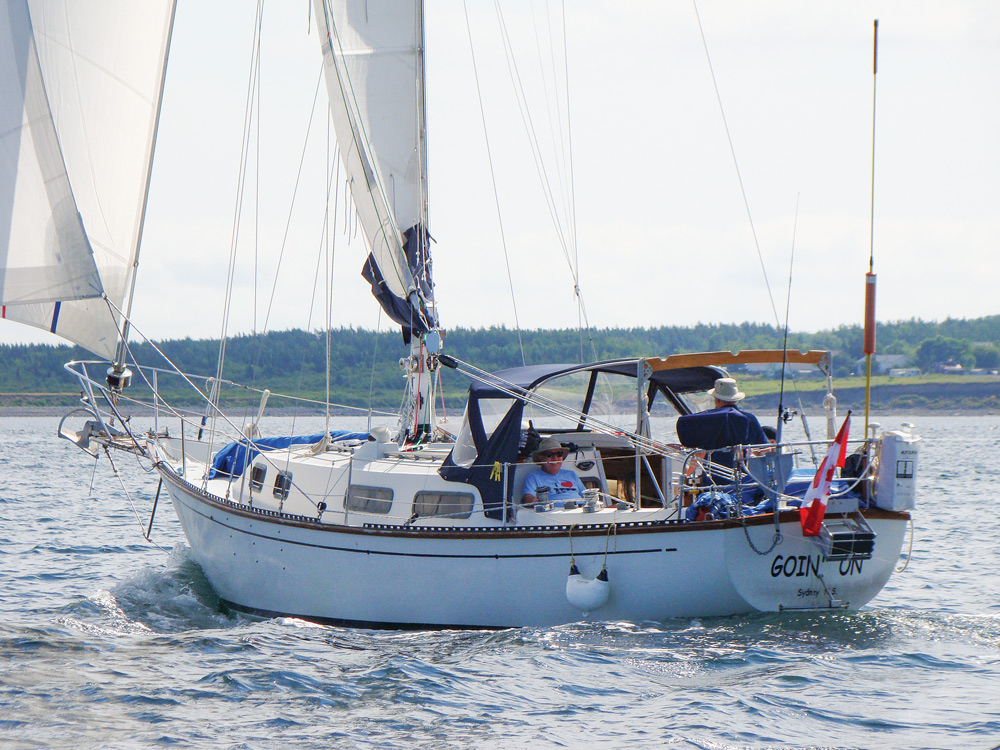
The boatbuilding company was a financial partnership between the Canadian government’s Cape Breton Development Corp. and two Toronto businessmen, Fred Karp and Jerry Goodes. Cabotcraft Industries set up shop in 1973 in a World War I-era naval building. Canadian boat designers Ted Brewer and Robert Walstrom were hired on to draw the plans. According to the unofficial company history, getting the first boat to the Annapolis boat show in 1974 was a memorable feat. Towed from Maine to Maryland by an aging 1950s Mac truck, the boat arrived on time and was well received.
By 1975, the production line in Sydney was capable of working on 10 boats in various stages. But the cost of doing business remained high and it was often difficult to obtain the necessary materials. In July 1978, after 49 Cabot 36s were built, some as kit boats, the company went out of business.
Attempts to revive production began when Brian Smyth, a Cabot 36 aficionado, entrepreneur, and chief engineer at Yachtsmith International in Dartmouth, Nova Scotia, purchased the molds along with a business partner and planned for a new line. At least one new Cabot 36 was constructed in 2005.
First Impressions
The Cabot 36 has the classic, conservative appearance of a sturdily constructed ocean cruiser. The boat has an upswept bow and chopped-off stern. Out of the water, the hull is distinguished by the so-called Brewer Bite, which looks like a bite was literally taken out of the full keel.
Brewer was convinced the “bite” would give the boat the windward advantage of a fin-keel boat and make steering in reverse a more pleasant experience. The “bite” allows for the rudder to be mounted at the aft end of the keel while keeping the propeller and rudder fully protected.
In a review about keel design, Brewer wrote that the “bite” is a way to modify a full keel. “The size of the cutout depends on how insistent my client is on having a full keel, and I try to make the cutout as large as I can decently get away with,” Brewer said.
Brewer didn’t claim to have originated the bite, noting “the late L. Francis Herreshoff used a not dissimilar profile many years earlier in the design of the lovely 57-foot ketch Bounty.”
Construction
The Cabot 36 is a traditional fiberglass boat built from a mold. Its deck and hull are cored with Airex rather than marine plywood or balsa wood, like many other boats of its era. Airex is a strong material but does not absorb water and so does not bear the threat of seawater infusion and subsequent delamination.
The modified full keel has lead ballast to help it stay upright in a blow. Owners have described the boat as “fortunately overbuilt,” its solid construction evident above and below deck. Jim Marsh, John Perring, and Walstrom did the lofting from Walstrom’s plans and Brewer’s line drawings.
What to look for
Given its age, an original Cabot 36 would likely require upgrade in its electronics, communication equipment, navigation instruments, and perhaps some engine work. The dodger and bimini might also need replacement, as would any sails that have outlived their performance capability.
Canadian Wilson Eavis, who lives in Sydney where the boats were made, owns hull No. 45, the 1977 Cabot 36 Goin’ On. According to Eavis, the boat was sailed on the Great Lakes, so it was not outfitted for ocean passagemaking.
“We could tell she was gently used with her original sails and a brand-new, oversized diesel engine with just 27 hours total running time,” he said.
Since Eavis and his wife were planning a five-year global cruise, they bought new sails, solar panels, anchors, communication equipment, auto-pilot, chartplotter, windlass, compass and a deck-wash system.
“We swapped out some old gear for new equipment, as technology is advancing so quickly in the cruising world,” he said.
Not every Cabot 36 would require such extensive upgrades, but at minimum the standing rigging should be carefully inspected for wear. Attention should also be paid to the deck and cabintop for leaks, particularly at stanchions, chainplates and other deck fittings. The engine might also show signs of wear or lack of maintenance, evidenced by oil or fuel leaks, brittle fuel and exhaust lines, thinning belts, loose mounting bolts, and other telltales.
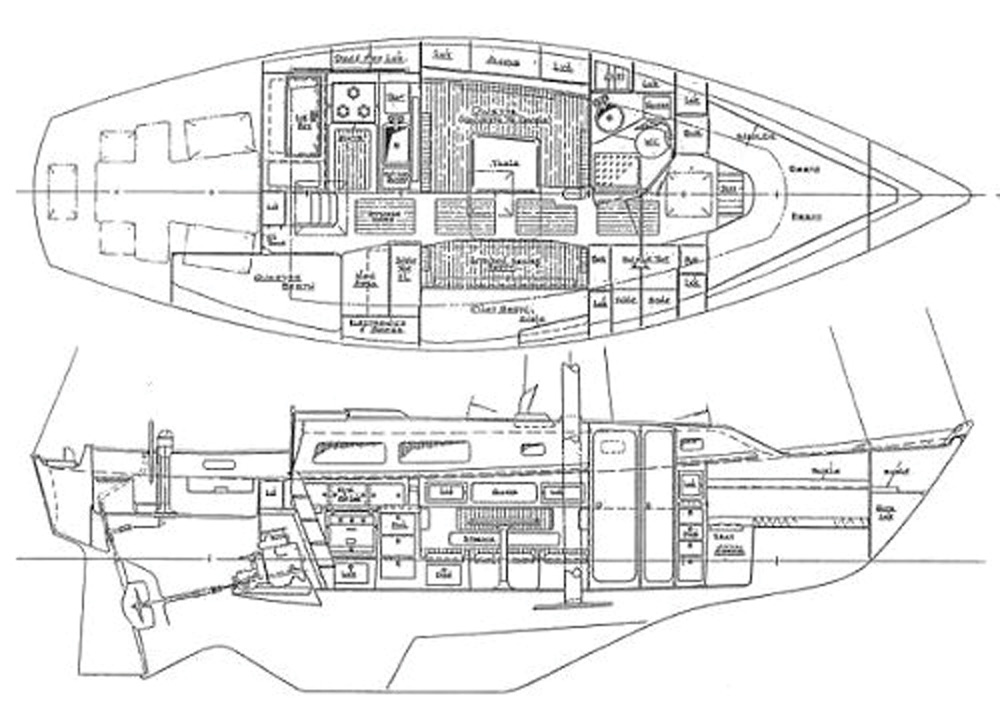
A stainless steel bow pulpit and stern rail add to the boat’s overall appearance as a heavy-duty cruiser. Stanchions, lifelines, dodger, bimini and roller-furling headsails were all part of the package. The deck features an aluminum track along the toerail to accommodate sheet adjustments and gear attachments. The mainsheet and traveler are located aft of the helm seat.
The T-shaped cockpit has adequate room for crew, enhanced with a raised helm seat. The seat can be reversed to serve as a bench across the stern. The cockpit has teak floorboards to keep feet dry and further enhances the boat’s nautical look. There are five opening bronze portlights for illumination and ventilation.
Down below the Cabot 36 exudes what owners describe as a feeling of coziness. Most of the fiberglass hull interior has been covered over with rich teak bulkheads and cabinetry. The woodwork is handcrafted and the joinery finely made.
Also in Used Boat Notebook
- Hunter Passage 42
- Pearson Rhodes 41
- Santa Cruz 52
- Allied Princess 36
- Kelly-Peterson 46
- C&C 36 Invader
Also from David Liscio
- Chasing a dream
- The wide, wide world of multihulls
- Flares are expired. Now what?
- Saved from the scrap heap
- Pedal to the Medal
The Cabot 36: Classic Blue Water Sailor
A site to celebrate this great Canadian passage maker.
Contributors
- SaltyOldDog
- The Bees Knees
- Don and Susan
Roy Mac Keen
Sept 2010 Rudder Repair Exchange
Another rudder gone bad, overhead lighting wiring.
- Seasons Greetings and a cockpit safety harness que...
Holding Tank Installation Questions
Questions from old sam, greetings from hull #50 d.w. crow, connect with the voyages of c.w. crow (#50), for sale - shogun - hull # 51, cabot for sale.
- Make a New Post
- Cabot36.com
- Cabot Documents
- Cheshire Cat Log
- Voyages of C.W. Crow
- Ted Brewer: Cabot Designer
- October 2005
- November 2005
- August 2006
- September 2006
- August 2007
- September 2007
- October 2007
- December 2007
- January 2008
- August 2008
- September 2008
- January 2009
- February 2009
- August 2009
- September 2009
- October 2009
- November 2009
- January 2010
- September 2010
This is a paragraph of text that could go in the sidebar.
Monday, September 27, 2010
Rudder Repair Exchange: September, 2010 (See Roy Mac Keen's diagram of the rudder in list of documents .) I lost control of my steering on a wonderfully blustery day recently and had the boat hauled; I've now received the unwelcome news today that the webbing on my rudder is gone. I'm headed for the local boatyard next week to look at the situation up close and personal and get their estimate advice on the repair. I have plenty of experience with ambitious epoxy repairs, and have studied the helpful materials posted on this site, but remain reluctant to tackle the project on my own. I would welcome any advice o n how to proceed... Chuck Goodrich [email protected] Sept 26, 2010 I am not sure where you are, but there is a company in Florida that will make you a NEW rudder for around $2,000. (Newrudders.com) When the one went out on Blue Magic I had a stainless steel one made. The outer skin was sheet stainless steel and once primed and painted it looked exactly like the old fiberglass one, except I had a notch put in so I could pull the shaft out without pulling off the rudder again. Good luck. I know how much time it takes and how much epoxy it will also take, your better off with a new one. Banff The former owner of Hull #33 Blue Magic Sept. 26, 2010 The rudder consists of mirror image fiberglass shells taped together around the rudder post. Welded to the rudder post is a plate to take the torque of the rudder. There are no ‘webs’ in the rudder.The ‘shells’ act as a fairing only. Step One: Split the shells along the longitudinal centerline of the rudder. This can be done with the rudder in place. The shells MAY be stuck to the rudder post or plate with foam, milled fibre, resin and you may have trouble removing the shells in one piece. One side should come off fairly easily. There is ballast ( steel plate punching) in the bottom of the rudder. Step Two: Please send me a photograph of the stripped rudder and I will comment immediately. Step Three: I suspect that the weld fastening the ‘plate’ to the rudder stock has broken and/or deteriorated causing the rudder stock to rotate without the benefit of the torque plate to swing the rudder. ( One now knows not to mix metals without some kind of cathodic protection). Step Four: That being the case, have the plate rewelded to the stock. I don’t have to tell you to be careful of alignment. The plate will be welded to one side of the rudder shell, not on the centerline of the stock, to permit laminating to the shell. I look forward to your photos Roy Mac Keen Sept 27, 2010 Good Morning, Though I might offer something here….. We don’t build the rudders and rudder support the way they were originally built, we now make the internal support web out of 316 stainless steel and try our best to fill the entire rudder so it is as solid as possible. It is possible to get replacement rudders from us as it will fit the original hulls, but you mad have to change the rudder post seals. This might actually be less expensive. (A while later, Brian - who has mistaken Roy for a boat owner - writes:) What we have been doing for the heel bearing is to fabricate a stainless steel fitting from pipe. The inside diameter of the pipe is around 3” so we mill up a bearing from UHMW to fit inside the pipe and the rudder stock fits inside that. If you have the measurement of the hole in the heel bearing you have, we can make the rudder bottom shaft that size. Brian (Smythe, of Yachtsmith International) Sept 26, 2010 I didn't get Roy's message for some reason -- many thanks, Ken. His reply is most helpful and the information from Banff is also interesting. I found a Florida company called Foss that makes rudders, but they are NOT stainless. I did hear from Willaim (or William?) Parrott, who went through the same thing but sounds like he made a successful repair. His note to me is pasted in below: Chuck --------------- On Sun, Sep 26, 2010 at 1:07 PM, Willaim Parrott wrote: I had a similar problem about ten years ago. I removed the rudder and ran a circular saw around the edge and separated it like two pie plates. The rudder post was stainless but it had mild steel webbing welded to the post. That is where it failed. I had all new internals welded up much stronger than the new one. Reattached the fiberglass shell and filled it with closed cell foam and its better than new. Had the boat surveyed a couple of years ago and he commented on the dry rudder. The yard estimated the job between $3k and$4k. I did it less than $500 material costs. I can get very detailed if you would like. Let me know and I can walk you through it. Bill Hello Chuck, My father Tony, use to own SHoGUN ~ a Cabot 36.. He has 2 sketches of the Cabot rudder, from Nassau Shipyard Ltd... We could fax them to you, as they cover a whole page each... Please provide us your fax # and we'll send them off asap. Lisa (Waldegrave)
Friday, September 24, 2010
Labels: Rudder Repair
Tuesday, May 18, 2010
Have any Cabot owners had to replace any of the overhead wiring to the cabin lights? As the wires run between the coachroof and the inner lining it is difficult if not impossible to access. How have you overcome this problem and run new wires?
Friday, January 01, 2010
Seasons greetings and a cockpit safety harness question.
Hi folks. Happy New Year from Old Sam (hull 42)! We know lots of you are lucky enough to be sailing somewhere warm and interesting as we write. We, in Nova Scotia, however are sitting by a fire, watching the snow fall, looking lovingly at pictures of our boat and counting the months (FIVE!) until we're back on the water. Many thanks to those who helped us out with our cockpit drain and (?) race handicap questions. The drain is now installed and we have peace of mind! Our new question is about rings for safety harnesses in the cockpit. We do have jacklines running from the front of the cockpit forward but nowhere to secure a lifeline inside the cockpit. Keegunoo has a ring on the aft end of the each cockpit locker (in the T) They like it Ok but it seems like it might be a leg catcher. Also, we wonder if there is a place closer to the companionway that doesn't get in the way of day to day activities-the only place we can think of is right underneath the companionway opening. Our email is [email protected] Thanks lots for your help. Susan and Don
Sunday, November 08, 2009
I'm finally facing up to the inadequacies of my late-1980s holding tank installation; would appreciate advice out there from those who may have been brave enough to go down this road before. My leading scenario is to put a tank with ~80 gallons capacity (48" long) under the port berth in the dining area, having someone manufacture a custom tank to fit the contours of the space. I would then create a large access port in the side of the locker, replacing the current fiberglass with marine teak. Among my questions: Is this the best location? How have others arranged for access to the space (alternatively, I could cut into the horizontal surface beneath the bunk, but this appears to be potentially more of a structural issue) Is it worth the added complexity and expense of a custom tank to accommodate the angles created by the hull shape, or should I just go with something that is rectangular? I would appreciate any advice that may be out there....
Sunday, October 18, 2009
Hull #42, formerly Old Sam Peabody was officially renamed Old Sam on June 5, 09 with all the appropriate (we hope) invocations, lots of champagne and celebration. We're pretty sure the boat wanted to keep its name- we came up with lots of other ideas for a year and a half but none of them "worked". David and Susan Chase, the previous owners kept Old Sam Peabody for their new trawler but they agreed the boat would be happiest with part of it's old name. And for those of you familiar with Maritime liquor, you will certainly recognize this name as a pretty good rum! We've had 2 amazing summers learning just how great this boat is-making some small changes to things so they work better for us but basically loving the sail plan, living space and performance under every kind of condition we encountered. Thanks SO much to Archelon and Keegunoo for all their advice, help and support! We have 2 questions that we think have to be answered by you Cabot owners: If you could email us directly at [email protected] it would be better-we are pretty new at the blog thing! 1) For winter storage (the boat was always stored inside until it arrived in NS), does everyone have bilge drains? We had big problems last winter with water (freezing) in the bilge but because the bottom of the bilge is so deep, we worry about how we would reach the drain if it failed while in the water. Any thoughts would be greatly appreciated since it IS getting colder every day! 2) This is so ridiculous we're embarassed to ask but .....we all know Cabots are built for comfort, not speed but we do participate in a neighborhood race every Labour Day. The organizers have no idea how to handicap us so if anybody has any idea of what our class handicap would be,we'd love to know since (like every racer on the planet) we think we are very unfairly handicapped right now! And if any of you are near the waters of Mahone Bay next year, you'd be most welcome to join the fun.
Tuesday, September 22, 2009
Tuesday, August 25, 2009
Just got this connection from Bob and Martha Ciupa, now navigating the world in their Cabot. A great website to keep in touch. Check it out.
Friday, June 26, 2009

Tuesday, February 17, 2009

Sunday, February 15, 2009

Monday, January 05, 2009
Christmas greetings 08 from cheshire cat.
HI AND HELLO TO YOU ALL; Just a brief note to say that Mike and I hope you all have a Very Merry Christmas this year and we trust that only good things come your way in 2009. Cheshire Cat is in Bundaberg, Australia - after a relatively uneventful season in the islands of Fiji, Vanuatu and New Caledonia. The main event was an ongoing problem with our new engine exhaust. Very annoying! However all is well now - thanks to cruiser friends who helped Mike solve the problem. We had a good time in the islands seeing and experiencing the very different culture and enjoying the company of old and new friends. Next year should see us moving north up the coast to Darwin where we plan to join the Sail Indonesia Rally - then off on another adventure on our way through Indonesia and Malaysia. We always like to get your news, so please keep the emails coming! I WILL try to get better at replying (especially as I have a new computer this year!) Love and Best Wishes from Deirdre and Mike
Saturday, January 03, 2009
Hull 18 (mimi) undergoes major re-fit.
Ken: I have purchased hull number 18 (MIMI ) from Steve Batchelor in Melbourne Florida. .Scott Schloessor, also a Cabot owner, sailed up with me from Melbourne to Green Cove Springs Fl. It was a good sail up the outside and we experienced a full spectrum of weather. I was impressed with the boat’s performance. So much so that I decided to make this hull number into the ultimate cruiser. I am completely redoing the boat. It has a new Yanmar 30 hp motor, new fuel tank, new wire rigging, a mast head radio antenna, tri/color, anchor, strobe masthead light, windex, all new sheets and halyards, new main sail, and good head sail and stay sail. The plumbing work is now in progress re connecting both water tanks and installing sediment and charcoal filters and new water pump. Planned is a new stove, refrigeration by Mermaid, new batteries, battery chargers and the installation of an older model HydroVane wind vane along with the original auto helm wheel belt auto- pilot. I live aboard and travel on a Formosa 51 but am really enjoying redoing a real cruising sailing boat. This boat will be for sale when finished so I'll keep in touch with some progress reports.. Sincerely Frank Holland.
Pegasus III

Thursday, September 11, 2008
Mystery cabots.
About 25% of the original boats are ghosting along out there as "Mysteries" to the owners association - or those of us who come to this blog now and then.
Since I began researching the Cabot, I've been fascinated by the stories that come in about boats and cruising adventures. The first one to spark my interest was, of course, George Kephart's. (His is posted on the website.
I'm hoping Cabot owners will keep their eyes out for these mystery boats, and have an owner's list (see website) to double check in case the boat you find is one we haven't! Here's a list of hull numbers that either remain entirely off the radar, or from whom we have not heard reports in ages (likely since the original owner.):
10, 11, 17, 21, 23, 35, 49, 56, 57, 58
These two digits would follow the initial ZBD360 that start all the boat hull numbers, stamped on the outside of the transom.
Here's the kind of story that makes me want to track these down. Arthur Morris writes in 2006, about Hull #37:
"I was looking through some old papers the other day and found some hull numbers that my teen age son had copied down back in the 1980’s. One of the hull numbers was ZMD 360 37177 and the boat’s name was “HIGHLAND HEART”. After I saw the name I remembered the boat. It had been owned by a member of the Atlantic Symphony Orchestra (not the original owner), who had sold it to an Air Force Officer and was based at the Shearwater Yacht Club. The last time I heard of the boat it had sailed to Florida, but I do not know the present owner or location. The boat was the only CABOT 36 that I know of that had a wooden pilot house built over the companionway and part of the cockpit. I was on the boat a number of times and the rest of the boat was the same as the normal CABOT 36."
In the summer of 07, Roy Mc Keen adds to this:
"James Mac Donald of Baddeck N.S. first bought the hull and lead keel from Cabotcraft and planned to finish the boat with wood deck to his design. James is an accomplished shipwright, having served his time with Walter Pinauds yard but we did not know how the displacement, trim,sailing characteristics etc would be altered by the conversion so we removed the Cabot logo from the bow. James completed the boat by adding our interior liner, deck and liner and then converting the aft deck to a pilot house configuration. His plan was to head north to Newfoundland andLabrador so the addition was useful for cruising that area. She is the only boat with a pilot bouse and when commissioned had tanbark sails. "
But where is this boat now? Wouldn't it be great to have a picture of her to see how she turned out?
Here's a challenge for you. Check the owner's list and see if there are enough details on a particular "mystery" boat to launch you on an Internet search to find the owner.
Tuesday, August 05, 2008
Standard rudder port.
HERE'S A GREAT REPLY FROM ROY MAC KEEN TO MIKE AND DEIRDRE OF CHESHIRE CAT . ROY'S SKETCH IS LINKED IN THE MESSAGE BELOW. MANY THANKS. It does not seem possible that I am sitting in Boca Raton, Florida, doing a rough sketch for Cheshire Cat in Fiji while I am watching NASCAR from the Pocono's! Cabot was fitted with standard Buck Algonquin Rudder Ports ( not to be confused with 'stuffing boxes' ) which have a long spigot containing a standard cutless bearing surmounted by a packing gland. Out of sight, out of mind, the packing in the gland dries out during docking periods and also wears only on the 60 to 70 degree arc.of rudder stock movement. Worn packing and eccentric wear on the cutless produces a trickle of water and a worn cutless bearing. Let us hope that the harder rudder stock has not worn through the rubber of the bearing and the bronze side wall of the spigot as this will necessitate the replacement of the rudder port. !. The simple and temporary solution would be to center the rudder stock and repack the packing gland. This is not a recommendation for a trans Pacific crossing but if no other solution is available and the know problem can be attended during the crossing, it could work. 2.Unfortunately one of the things that we could not make 'maintenance easy' was the repacking of the rudder gland. If I remember correctly, there is not sufficient clearance between the gland nut and the bottom of the quadrant to remove the nut and repack the gland. . 3. It is not difficult to remove the quadrant, assuming you are a midget and can lay on your back inclined toward the stern. Relases the tension on the turnbuckles, drop the wire and slack of the nuts on the quadrant. This is a good time to look at the pulleys and condition of the steering wire.. 4, The bottom of the rudder port should emerge from the outside of the hull sufficiently to see a hex retaining screw which holds the rubber cutless bearing in the holder.. ( It may be covered with fairing material; dig around) 5. You will have to remove the bolts in the bronze shoe to drop the rudder. R emove the bearing with a two leg or sleeve puller ( The countersunk screw is a "safety" only. The bearing should be snug in the holder. If I remember correctly the rudder shaft is 2" in diameter and therefore the OD of the bearing shell would be 2-5/8" or 3" in diameter. I would guess the former. 6. Obviously, check for wear within the bearing shoe and the bearing area of the rudder stock.which you have it apart. Good luck, Let me know how you get along
Sunday, August 03, 2008
Rudder issue: cheshire cat.
Hi Ken, We were trying to leave Fiji for Vanuatu last week when I noticed that the rudder position indicator on our new "Coursemaster" autopilot was off so I emptied the locker to look at it and found that I had water coming in through the seal on the rudder stock and there was a slight movement at the top of the stock. We returned to Fiji to check it out. Do you or anyone else have any ideas on how the seal is made and can it be replaced in the water with taking off the quadrant. In fact I assume that the whole rudder is only supported by the skeg and there is no other means off attachment above the water line. The rudder itself seems solid with very little movement in it. Thanks Response from Blue Magic (#33) On Hull 33 it’s a simple stuffing box type with shaft packing. You should be able to pull it apart in the water no problem. The only problem may be how much clearance you have on the top of the shaft to the deck, but you could always cut a hole and replace with a high quality hatch/deck plate. Good Luck Banff Luther Luther Marine Maintenance Blue Magic #33 ...and from David Ladell Here are some digital camera shots of the drawing done by Ted Brewer. Not great but you may be able to make them out. It appears to be the same as what was done on Hull #27. David Ladell ...and from George Kephart (original owner of Sarah Fraser) I had this problem on Sarah Frazer. We solved it be having and extension welded on to the rudder shaft up to a bearing ring in the sole of the cockpit. The bearing ring was at the very aft end of the cockpit under the .seat andn ever caused any problems thereafter. George Kephart
Friday, May 16, 2008
Cheshire cat leaving new zealand.
Just a few more days to go before we leave New Zealand - we are working hard to get everything ready and, as they say, shipshape. Of course there will be a number of things still to do as we seem only to work under the pressure of a deadline. But many of those tasks will have to wait until we hit the balmy weather of the next tropical island! Sounds good doesn't it? Yes - we think so as well - it's getting far too cold here in the beautiful 'land of the long white cloud'. It seems we have missed the current exodus - Cheshire Cat is one of the very few remaining foreign boats - everyone else having taken full advantage of a week of glorious 'weather window'. But - with the added advantages of new autohelm, engine and canvas over the cockpit we will be in good shape. We have made all sorts of upgrades such as radar (it actually works!) AIS (so that we can identify the big ships near us) lots of paint, new upholstery, sinks, cooker, head, dinghy - an extensive (and expensive) list of goodies. New Zealand chandleries will be sorry to see us leave! But our bank balance will be relieved. So it will be with a certain amount of regret that we leave our friends here - landlubbers that they are now (mostly) and sally out again into the great unknown - to new adventures and new places. Hopefully we will hear from all of you - we'd like to know what's what wherever you are. Maybe even catch up with some of you as we explore Tonga, Fiji, Vanuatu, New Caledonia and Australia next season. Meanwhile - travel safely - enjoy - and please do write!
Thursday, April 24, 2008
Refitting hope light.
I am refitting Hope Light for the umpteenth time so we can get back to the Bahamas as soon as this fall or following year latest. We have added and changed equipment and gear regularly in the 28 years we have owned her, but have needed to do very little in the way of infrastructure change, just maintenance. I suppose this speaks well of the integrity of the Cabots in general. Among the myriad of things we are doing are, adding solar and wind power generation and we need to somehow design and have built a bimini to supplement the dodger for the cockpit that can be used to help keep off the sun even when under way (not an easy task given the long boom and aft traveller. I do have an uninstalled rigid boom vang/boom support that could eliminate the aft topping lift). In the past we have had a sunawning that gets set up when at anchorage that covered much of the cabin and all of the cockpit. Also we need to design a flange or something to prevent water from entering the anchor locker so easily. Better late than never. I am a leakproofing binge so any suggestions there would be appreciated. I am already covered in polysulfide. In the past we have had Surrette battery banks and have been very happy. As I replace them I am tempted to go with AGM batteries instead of flooded ones but don't think I will be attentive enough to keep them happy, such as regular full heavy duty charges. On the other hand when back in the Bahamas I predict dribs and drabs of charging from solar and wind. Any suggestions will be most appreciated. Thanks David
Monday, March 03, 2008
Cutlass bearing replacement - sizing.
Hi, I am repowering Meltemi this winter, replacing the Perkins 4-108 with a Beta Marine 28hp 3 cylinder Kubota based engine. While I am doing this I am taking the opportunity to replace the cutlass bearing. My measurements indicate that the inside diameter of the shaft log is 1 9/16 inches. However, there does not seem to be any available cutlass bearings with this OD, 1 5/8 being the closest. Is my measurement off? Are the shaft log and cutlass bearing metric? Did there used to be a 1 9/16 OD cutlass bearing size in the the late 1970s? Has anyone replaced their cutlass bearing recently and if so did you have this problem? Thanks for your help.
Sunday, January 13, 2008
Hello from the proud new owners.......
...of hull # 42 (formerly Old Sam Peabody-haven't settled on a new name yet) and we are so excited about being lucky enough to get one of these beautiful boats. We bought it from the David and Susan Chase in Dec. 07 -many thanks to them for their generosity, help. and the excellent care they took of her. This spring we plan to have her shipped from Michigan to Mahone Bay, Nova Scotia (yeah, she's getting pretty close to home!- and will be in the same boatyard as #43 Keegunoo) We will be sailing around the Maritimes for the next 2 summers and then plan to head SOUTH in 2010. This purchase changes our long, intense love affair w/wooden boats-we're currently sailing a 1936 Alden Malabar Jr. but we recognized we needed to make a change for our long distance sailing plans (she's a beauty though- and for sale, so if you know anyone interested, pass the info along.) The Cabot was the ONLY fiberglass boat that came close to being well built and beautiful enough! We'd love to hear from any other owners, especially if they get to (or plan to get to) our part of the world. Our email is [email protected]
Friday, January 04, 2008
Sold sold sold.
Old Sam Peabody (hull 42) has been sold and returns now to Nova Scotia. More news when we are in touch with new owners. David Chase, the former owner, says he thinks the blog helped in the sale. If so, good. Do send any notice of sale you might have. It also helps us keep track of boats. Ken
Saturday, December 08, 2007
Sea eagle (hul 55).
Hi Ken. I have some information for you. First off hull numbers. Off the transom # ZBD3605578. Also on the transom are the raised letters "HONCHILLA". From years of buffing around the plastic letters the raised areas are left immortalized on the stern.
I have the original registration in Canada by Dr. Hooper. It's to an apartment address in Ontario, Canada. All other paperwork is addressed to Washington DC, USA. Canadian registration has Dr.Hooper as Agriculture minister to Ontario. He may have been a Ph.D. and not a medical doctor. Maybe?
The boat was sold to a US Navy commander by the name of Frank T. Gieseman in 1995 or 1996. He was a commander of a US vessel in the first US gulf war . The radio call sign of his ship was, "SEA EAGLE". A sea eagle is a fishing eagle in the North Sea. I thought it was a cool name, so I kept it. The T in Frank’s name is short for Ty. Ty retired, bought the boat, and traveled some; then married a retired navy captain named Susanne. This year they published a book called Your Boat Too about women being confident on a sailboat. Check it out.
I bought the boat in April 1998. It's documented in US. My address is 2974 Riverside, Somerset, MA, 02726, Phone 508 965 3378, or email wm_parrott@ yahoo.com.
The boat lived in the same marina in the Chesapeake until I purchased her. Actually at the same slip until 1998. She was yard maintained until 1998. Yard maintained to many people means the best of care. I know it to mean the minimum of care at a high price. The boat was in fantastic condition but had few upgrades.
The boat has the original gelcoat. Still buffs up nice. I have rebuilt the Perkins 4-108, the velvet drive transmission, new shaft, and three blade prop. Rebuilt rudder with all new stainless internals. Electric windless horizontal and all chain with capstan. New sails, new dodger, bimini, wind generator, and radar, Cozy cabin heater, barrier coat, and much more.
I have pictures of the boat under sail from a helicopter, and some at anchor that I will send later. It's great to have an owners group that is active.
BillParrott
Wednesday, October 03, 2007
Cabot 36 weather helm .
Hi Guys, It's me again, with a question. I've heard some rumors from the guys at YachtSmiths, that the Cabot 36 has a bit of a weather helm. And, I've been told that at least one owner has moved the forestay out onto a small bowsprit which either corrected this situation, or at least improved it. I'd love to know how far the forestay was moved up, and whether this balanced the helm, or simply reduced the weather helm. One of the decisions I'm faced with, in the addition of the pilothouse, is do I trim a bit off the bottom of the main sail. The pilothouse is two feet taller than the cabin top. Based on the original drawings, I would still have clearance below to boom, as it was originally drawn, though not a whole lot. If the boat does, in fact have a weather helm, trimming say a foot off the bottom of the main, may not be a bad thing. Any thoughts or comments ??? Thanks, Mike
Tuesday, October 02, 2007
Cabot 38 pilothouse.
Hi Guys, I figured it's about time to introduce myself !!! My name is Mike Filimon, and I have been working with YachtSmiths to develope the Cabot 38 Pilothouse. The one under construction is mine, and will hopefully become a successful design for YachtSmiths. I will be putting layout #1 into my boat. The interior drawings you see on the CabotYachts web site are the result a continuing process of revising my revisions, until I think I have it right !!! And since they were posted I have made some small revisions to layout #1, based on observations I made at the Newport boat show this Sept. I had originally drawn the fore and aft dimension of the galley the same as it is on a Cabot 36, including that portion of the counter which extends aft, under the bridge deck. But, I will not be able to extend this counter the same way, under the pilothouse, so I extended the foreward counter a bit. The galley on the Cabot 36 is large, and looking at boats in the same size range at Newport, we found smaller galleys that were adequate. Because making room on this boat for the pilothouse does require some compromises, I have reduced that galley by 4 inches, to a fore and aft length of 5 feet 4 inches. This is still pretty generous compared to modern boats in the same size range, especially because many of them now have an L shaped galley, with access to a quarter cabin through the galley. I still like the traditional U shaped galley, (though in this layout, I had to compromise and make it more of a J shape) Forward of the galley, opposite that table, will be a small settee, unfortunately not long enough to serve as a berth, but comfortable seating. (On my own Cabot 38 PH, a portion of this space, just foreward of the galley, will be used for a cabin heater) I have also switched the hanging locker and bureau. The hanging locker is now on the port side, in the 15 inch space, and the bureau is on the starboard in the 20 inch space. I found that hanging lockers of this size were adaquate, and this seemed a better way to use these two spaces. I'm pretty sure I have it very close to the way it will be built, but we'll see what happens after my trip to the Annapolis Sailboat Show this weekend, and my trip to Dartmouth, Nova Scotia, in three weeks, when I'm spending a week with YachtSmiths, to mock up the interior and see how it all fits !!! In the mean time, I would love to hear from you guys with any comments, or suggestions you might have. I'm sure those of you who have experience aboard a Cabot 36, and even building them can be a valuable resource in this process. Just, please don't call be any nasty names for messing with what we all know is a GREAT boat !!! Thanks, Mike
Tuesday, September 04, 2007
Sold: old sam peabody (42), monday, august 27, 2007, shogun (hull 51) is for sale.
Tony Waldegrave has decided to sell SHoGUN, which he has owned for the last 28 years, having bought it shortly after it was commissioned for its first owner in Nova Scotia in 1978. For years, Tony established and ran the Cabot owners' association. Please visit the Cabot Documents site to see full information on the boat.
Tuesday, August 14, 2007
Interior modifications, thursday, august 02, 2007, sail blue magic (hull 33), that osmosis problem.
Thomas Groeneveld (JULY 27/07) This is Tom Groeneveld on Morning Light II , hull 29, in Curacao. Just put the boat on the hard and discovered a few blisters, maybe a dozen. Had many more 2 years ago and even more 4 years ago. Ground them out, let them dry and filled with epoxy and silica. Am amazed that the hull is in such good shape. Put a few holes in the rudder but hardly any fluid coming out. All is well and I will keep on sailing the Cabot.
Scott Schloesser here, hull 32 ( Cimba C36-32 )
I haven't dealt with it yet but Cimba has about 100 blisters in the range from 1" about 80 to 2" about 20 probably from the time it spent down in the islands , plus the rudder core is wet , trying to schedule for a fall haul out.
Bob Ciupa (Hull #50) July 28/07
I did my bottom for osmosis, voids, and barrier coat the hard way during the winter and spring of 05-06. Fell free to have Jan get hold of me, I have loads of info I'd be happy to share. P.S. If I ever get my hard dodger finished, I'll send you some pics of the boat and info regarding a name change.
Roy Mac Keen (July 29/07)
I would be surprised if 'osmosis' was not a problem with the Cabot, but up until the closing of the factory, we had no indication of the problem. As you are aware osmosis is the penetration through differential pressure of moisture through the gel coat. In the days of the Cabot, gel coat was resin thickened with calcium carbonate ( highly porous) with the addition of colour. There really is only one way to defeat it: Peel, dry, and barrier coat .
Banff Luther, Sailbluemagic (Hull 33) email July 31/07
Friday, July 27, 2007
Roy mac keen on boat hull numbers.
One of the first requirements for Cabotcraft Industries was to purchase the ‘reverse image dymo labler’ necessary to affix a permanent ‘carving mark’ in the hulls of the Cabot. As the majority of our market was export, it was absolutely mandatory to have this mark. BOLD VENTURE #14 has one so it would be illogical for #15 not to have one. It may be that some owners illegally filled in the number for cosmetic reasons.
The oval brass plaques were not introduced until mid production and were affixed to the aft cockpit just below the main sheet traveller where it could best be seen at a Boat Show. No other competition had them at the time. This little plaque would not have qualified as an identification marker as a carving mark for boats of all nations must be permanent.
More to come on this shortly. Roy and I are working on a piece that brings together information from various emails and attempts to increase the accuracy and scope of this information for all owners. (KD)
Monday, July 23, 2007
Hull #14 bold venture, monday, june 18, 2007, problems with the rudder.
The following 3 exchanges seem well worth a post. The first comes from Richard Ward (Hull 46). First response from Arthur Morris, a long-time Cabot owner and Engineer (I believe). Finally, Roy Mc Keen, who lead Cabot Craft Industries for the better part of its existence in the 1970’s responds. I must say Cabot owners (and former builders and former owners) are a loyal breed, and very responsive to inquiries.
Well here we are into a midlife refit or at least that is what it has become. Found a leak in the rudder on the trailing edge. Been weeping a little all winter but now it has surfaced as water inside the rudder. So looks like I will need to carry out some reconstructive surgery on it. My question is what is the construction of the rudders? Foam core, steel frame (if so I hope it's stainless), balsa core(I hope not), or what?
Let me know what you have found.
Richard Ward SV Ar Sgrail Hull #46 Sydney, Nova Scotia
Hi Richard, 18 June 2007
I owned “Cabot’s Mathew” and had to repair my rudder when I found severe corrosion on the rudder shaft, due to reversed polarity on a marine electrical supply in Florida . It was a very severe electrolytic corrosion and the shaft was pitted to a depth of 1/8 inch around the rudder post just below the exit from the hull. The top half of the rudder shaft was renewed and we had to expose the core to get back to good metal and avoid a fire on the urethane foam core. By the way there was no corrosion on the stainless steel framework and the foam core had not deteriorated. The boat was 12 was 13 years old when I had to repair the rudder.
The core of the rudder is urethane foam on a stainless steel frame work. I checked with various Cabot 36 owners over the years and with many other boat owners as well and most seemed to have water leakage at the base of the rudder over the winter. I honestly think that most rudders leak in water around the shaft and by osmosis through the fiberglass over time. My Cabot 36 had always been in salt water and I owned it for 18 years and cruised for 13 years and sailed over 50,000 miles. After the rudder repair whenever I hauled the boat for repair or winter storage I drilled 3 holes in the bottom of the rudder and water came out for some time and before returning the boat the water I filled in the holes with MARTINTEX epoxy.
I would check the rudder and make sure that there is no movement of the shell on the shaft or any looseness on the frame and just drain it every time you haul, because I am sure it will just leak again after any re-building. We never had any other problems with the rudder.
Arthur Morris
WOW! I leave Florida for a long weekend and we have three “Rudder” questions!
I will make some quick sketches to show the construction and e-mail to you tomorrow for general dissemination.
To answer any emergency queries, the rudder was constructed in two shells and taped all around . The rudder is ballasted with iron ‘punchings’, has steel plate stiffening and is filled with foam.( which will have shrunk) I can imagine, in time, the fiberglass to metal ‘joint’ around the upper post and the lower pintle will deteriorate to the extent of admitting water or the hairline fracture permitting the water to leave the rudder also permits it to enter when submerged.
More tomorrow
Tuesday, May 29, 2007
Traveller replacement problem.
I'm planning to replace my original Ronstan traveller with a Harken windward sheeting arrangement; Harken needs information regarding the bend of the traveller track, both horizontally and vertically. Apparently they need to know the "chord height" and length in order to manufacture the track properly. I'm hoping someone can save me some time and trouble on this by providing the necessary info if they've been through a similar exercise themselves. If not ... well, I'll do my best and be available to advise anyone else who decides to go through this process. Chuck Goodrich Home: (978) 468-6239 2 Farrington Lane South Hamilton, MA 01982 Fax: (978) 626-0043 Cell: (508) 380-7264 [email protected] Office: (978) 739-1301 (fax 1399) 72 Cherry Hill Drive Beverly, MA 01915 [email protected]
Thursday, September 21, 2006
The anchor windlass exchange.
Hi, this is Mike Wybo of Meltemi, Hull 48. I am considering the installation of an anchor windlass and would like the advice and experience of those who have already done this. I am leaning toward an electric windlass and would appreciate any photos of how you have installed yours. Hi Mike, Try to get hold of Thomas Groenveld, the fellow who bought Morning Light from us. We installed a heavy duty Horizon horizontal windlass. We had a double bow roller and divided the locker with marine ply, fiberglass, and epoxy so that the 150 feet (?) of chain could run into the bildge (to keep weight below waterline and a bit further aft), and so that the second chain and rode set would be readily accessible and not get tangled. For the year we lived aboard after installing the thing, we wondered why we hadn't done it sooner. It was a big project but well worth the time. I would be inerested to hear from Thomas as to how he thinks it works and if the installation is still intact. He might be able to take some pics as well. If no pics, I might be able to draw from memory. The windlass sat on deck just aft and a bit starboard of center behind the chain locker. It fed the chain through a hole in the deck that intruded into the ceiling of the V-berth by 6-10 inches and was fiberglassed off to create a tunnel back into the chain locker... eventually feeding into the bildge below the chain locker (and the theoretical extra water tank below the V-berth. Let me know if this helps. It was a great addition to the boat. Mark Hunter Hi From Cheshire Cat 24, originally from Bronte in Ontario, now in Tonga. We have a lofrans windlass, horizontal mount as a vertical wouldn't fit. we have 200 ft chain with 150 ft rode and 50 ft chain with 100 ft rode. It all fits in the locker, but we have to hand feed it into place when we pull the anchor up Hey Mike, I installed a Lofrans Kobra this yearelectric 1500watts. Believe me it has changed my life. I have 175 feet of 3/8 BBB chain on the main and 25 feet with 200 feet of rope as secondary. There is a divider down the middle that allows this. I do have to hand feed the chain in as its tight to fit that much in there so placement by hand is required.(basically laying the chain as it comes in. Someone years back modifyed the locker and cut the opening door in half-installing a manual windlass on the aft half of the locker door. Underneath they installed a 1/4 inch stainless steel L bracket bolted to the forward bulkhead (v berth forward wall.) When I painted the decks I made the half door,(didnt open) part of the boat by laying down fiberglass cloth and filler to make it look like part of the deck. Now there is just a small door that pops out of position to access the locker. I had to cut through this steel bracket with a metal cutting disc to allow for the motor which goes into the deck. Installed was 2/0 ga tinned wire run from the battery bank (under setee) to the control box which i mounted in the forward cabinets above the v berth. Look at the first album in this link. You will probably enjoy the rest as well. Banff Luther Blue Magic #33 Charleston, SC Hey Mike, James Blinn, Archelon, Hull 44. I installed a manual horizontal Sea Tiger. I had to remove the anchor hatch cover, fashion a sturdy welded aluminum structure that was bolted in a number of ways to the the deck and anchor locker. Basically I can open 1/2 of the locker and the other half has the windlass on it and is fixed in place. I works really well and have had some nasty pulls on it without any problems at all. I have a single picture that may give you some help. This is taken standing on port looking toward stbd bow. I can take more if you are interested. I use 120' of 5/16 BBB with 300' of 1/2 Samson gold. No problems. I thought the 5/16 would be a bit light, but it fits in the locker well and has answered well in every case. Hope this helps. Cheers, James Michael, On Hope Light, our Cabot Hull #27, we installed a 3" diameter SS tube anchor/bow sprit. It is thru bolted to the hull a few inches below the toe rail and supported at its fore end, from below by a ss bracket that is bolted thru the stem. The sprit extends forward maybe 24 or 30 " from the stem at deck height and goes aft along the hull about 36" on each side. I'll take some pics and send them to you. On the bow sprit there are two large stainless steel rollers facing forward. (it would be better if these were each angled slightly outboard to facilitate more space for pulling up large anchors.) I had it made and installed it before we spent a year in the Bahamas in the 80s. Then we had a 44 lb. Bruce, a 35 lb and 25 lb. CQR, A piece of 5/8 twist nylon with 30 ft of chain on it. We also had and still have a 600' piece of 5/8 nylon twist stowed down below in case we needed it. We never have. Since then I have installed an electric Simpson and Lawrence Anchorman vertical windlass with chain gypsy and drum for rope. It has done a great job in all respects. It, and an electrical foot switch are mounted on a large rectangular, running fore and aft, 2" thick teak pad. It is placed on the deck starboard side aft of the chain locker. I now have 250' of 5/16" high tensile chain which is always attached to the 44 Bruce. The chain runs unobstructed from the chain gypsy to the ss bow roller an d to the hawse pipe which is mounted thru the centre of the chain locker lid. I usually only store chain in there with maybe some shorter nylon rodes so there is room for the weight of the chain to fall in and pull it down as the chain stripper takes it off the gypsy. I keep my eye on it and give it a help when needed but it works on its own surprisingly well. As well it feeds out of the hawse pipe quite well but I make sure there is no strain put on the rather flimsy anchor locker lid. Gravity still takes my anchors to the bottom so I only power up, not down. I can still raise and lower the anchor locker lid as its easy to get some slack in the chain and get it out of the way, although I seldom find I need to access it On the bow now in addition to the 44 Bruce is a SL 33lb fixed Delta anchor instead of the CQR. I still keep the 25 lb CQR below in case I need it. I like the fixed aspect of these anchors as opposed to hinged like CQR ploughs as they dig in much faster. Especially important in the Bahamas. The rather large electric motor of the winch is attached below the windlass and is easily installed as it is aft the anchor locker so its thru the stbrd side of the fore berth, foreward of the open lockers that are already there. I cut a large hole in that stbrd bulkhead and put a teak door on it so it closes it in and it looks great. I put a large dedicated Surrette deep cycle battery in the bottom of the foreberth hanging locker and attached it to the windlass and alternator charging area aft with an extremely thick copper cable that I bought at a welding supply place along with fittings etc. Ill take some pictures when I can and get them to you. Dont even think about anything but electric. I for one am not getting younger. I went thru a long analysis and the pros and cons of vertical vs horizontal. I know I did the best thing as it works so well. I have a pump which I havent installed to wash down the chain and deck but as I refit Hope Light in the next while I will install it. Cheers, David HEY EVERYONE. EXCHANGES LIKE THIS CAN OCCUR REAL EASY ON THE BLOG. FIRST OFF, IF YOU WANT TO BECOME PART OF A TEAM CREATING POSTS ON THE BLOG JUST LET ME KNOW AND I'LL WORK ON CREATING THAT. BUT THE OTHER WAY IS FOR ME TO POST THE FIRST INQUIRY ON THE BLOG AND THEN EVERYONE MOVES THERE TO WRITE RESPONSES, RATHER THAN WRITING TO ME. KEN
Thursday, September 14, 2006
Ar sgrail (hull 46).

Tuesday, August 29, 2006
Archelon (hull 44).

Monday, June 05, 2006
Hull 42: old sam peabody.

Saturday, March 25, 2006
Imagine (hull 28).

Tuesday, March 14, 2006
Drummoral (hull 38).

Tuesday, March 07, 2006
Send photos.
We would love to post a picture of your boat on the website. Please send that (and a little history for the text block) to Ken Draayer. You might indicate if you want your own email address used as a link in the post so people can get in touch with you.
The New Cabot

Cabot's Matthew

Sunday, November 06, 2005
Cheshire cat (hull 25).

Wednesday, October 19, 2005
Sarah frazer (hull 54).
Meltemi (Hull 48)

Sunday, October 16, 2005
Mystery boat #2.

Bold Venture (Hull 12)

Windrose (Hull 36)

Cottonwood II (Hull 22)

The Cabot 36
Sailing Vessel Palani is hull number 18 in the Cabot 36 series. She was manufactured in Canada in 1978. She is rigged as a cutter; this means she has three sails. The main sail, a large genoa located at the bow and then a smaller jib that is between the main and genoa.
She is a shoal draft full keel boat. I was looking specifically for this type of hull design as they perform well in weather on the open seas and the shoal draft works well for Florida and the Caribbean. Her draft is 4’ 9”.
Inside, as you come down the companionway, she has a galley (kitchen) to the left with a propane stove, a sink, and a refrigerator. On the right are the navigation station and a quarter berth for sleeping when underway. As you move forward, there is seating on the left that wrap around a kitchen table and a settee on the right-hand side. Next is the head (bathroom) on the left with toilet and shower and forward opens up into the v-berth cabin.
Here are some of her specs:
LOA (Length Overall): 35.5′ Displacement: 17800lbs (about 8 tons) Draft: 4′ 9″ Designer: Ted Brewer / Robert Walstrom Built By: Cabotcraft Industries

Related posts
Little sunday drone work, fort myers beach… again, new boat, new plans.
[…] January 2017 a 50′ trawler hit my first boat (a Cabot 36) and did a bunch of damage. On the Monday after the insurance check cleared (last month), I went on […]
[…] pictures from the cockpit of the sail boat […]

- Margaret’s Blog
- Jeff’s Blog
Caper – Another Cabot 36
While we climbed down the ladder from Cottonwood II – and presumably the whole time we had been on the boat – Joe and Wally were engaged in conversation about boats. I can only imagine the stories they were swapping about yachts they have owned, ones that they lusted after, and others that still cause them nightmares in the middle of the night. As they continued talking, all four of us crossed the parking lot to Caper, the other Cabot 36 we had come to look at. Caper had been the Cabot I was really excited about seeing. Not only was it listed for five thousand dollars less than Cottonwood II, but it had more electronics, better gear, and a large sail inventory. While I already knew from the pictures that the electronics were old – especially the SSB and radar – I liked the idea of familiarizing myself with these items before we invested the big money in replacing them. Moreover, old electronics fetch strangely high prices on Cruisersforum. It is as if there are people competing to own the most complete collection of gear from the 1970s and 1980s, possibly in anticipation of opening a world-renowned cruising electronics museum.
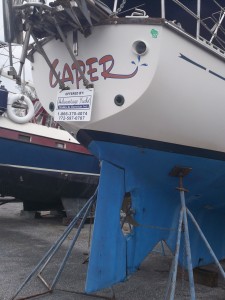
Caper – A Cabot 36
At first glance, Caper also looked better than Cottonwood II, probably because it was without the hideous hard dodger that the latter sported. After checking the hull, rudder, and propeller, we climbed aboard. The topsides needed a little work with all the cowling vents needing replacement, clear signs of rust beneath the plastic covering on the lifelines, and a slightly loose binnacle. But there were also self-tailing winches in the cockpit, a small serviceable arch, and some older, but good, furlers on the forestays. An ancient mainsail furler was situated on the blue painted mast and boom. The previous owners had supposedly took the main furler off the boat a few years ago, only to reinstall it after months of sailing without it. I would definitely want to get rid of it, and started to wonder whether that would necessitate a new main or, at least, a sailmaker to sew some batten pockets into the existing sail, which was only a few years old. The blue mast and boom looked strange and was clearly not Awlgripped, but I could live with for a few years at least.
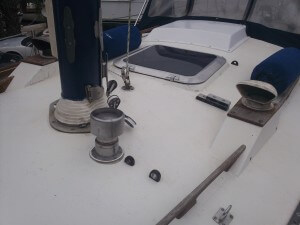
Going below, it was instantly clear that Caper’s owners had not cared as much for the cosmetic aspects of the boat as Cottonwood II’s had. This was fine with me, because the owners did seem to have cared for the wires and hoses in the bilges and behind the settees. With the exception of the wiring to the masthead in the bilge, the wires all looked to be fairly new, and the electrical panel was clean and well-organized. The hoses were all respectable, and it did not look like anything was in danger of splitting open, though a few would need to be replaced sooner rather than later. The thru-hulls and seacocks also looked older, but we would probably be replacing them on most boats we bought, so this was not a huge concern. Margaret will surely comment more on the aesthetics of the interior, but I will just say that there was some nice shag carpeting in the cabinets above the settees that left me searching for the lava lamp.
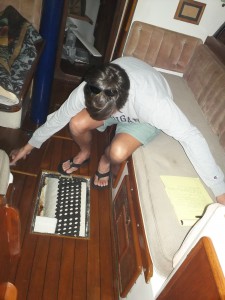
As expected, the electronics were indeed older, but it was nice to see they were well cared for and arrayed nicely around the nav station and companionway. The engine had been replaced in the 1990s and it – or at least the hoses and fittings attached to it – looked better than the nearly new one on Cottonwood II. Twenty years can be a bit old for an engine that was not cared for, but this one showed signs that it had been fairly well maintained, which made me think it might just run for ever, especially as it was a Yanmar. There were also at least two additional items that were not listed on Yachtworld. The first was a nice looking sea anchor. The second was a sweet pair of sunglasses that looked to be a knock-off of Vuarnets from about 1987.
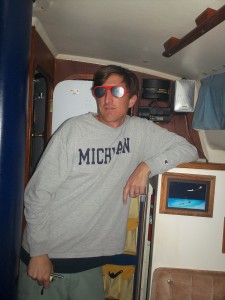
It is hard to say anything bad about a boat whose owner clearly has style in spades with the cheap shades and shag carpeting. And I could see a lot of potential in Caper. There was obviously a lot of work to be done on her, but there were also no major, glaring problems. Though our attention would quickly shift away from the boat, for the moment I was thinking she was a definite possibility.
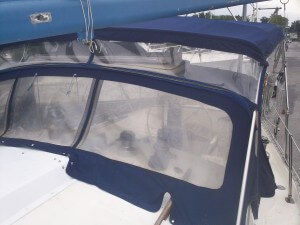
Margaret’s thoughts:
I have to say that I wrote off Caper pretty early in our inspection due to the awful aesthetic choices that the owner, or previous owner, had made. Her blue mast was an eye sore from across the parking lot and it was just the tip of the iceberg. On deck, one of her strongest features was the cockpit, with T-shaped seating making it easier to move around the wheel. The soft dodger and bimini, on the other hand, were worn and faded and would need replacing soon.
In the cabin multiple acts of poor judgement were apparent in the pink velour cushions (perhaps original), the blue painted mast, the mismatched formica counter tops, and the cabin top liner littered with patches.
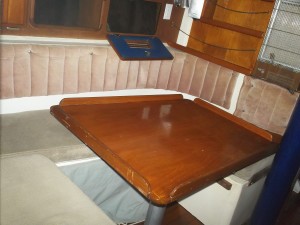
In complete harmony with the shag carpet in the lockers and the Vuarnets were the two dolphin relief sculptures below:
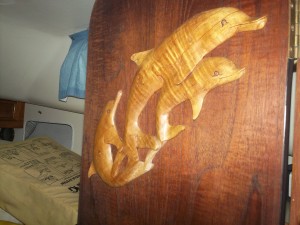
Sculpture on v-berth door
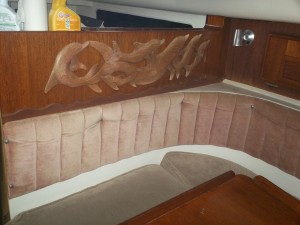
Sculpture in salon
As a design, there is nothing wrong with the layout, space, or proportions of a Cabot 36. Actually, this could be a decent boat if you replaced all of the formica and plastic with teak, the plastic ports with bronze, made new cushion covers, and stripped the mast. We just aren’t up for that type of overhaul. But if you don’t care about aesthetics, and just want to get cruising, this would be a good choice for those with a budget in the low to mid-$40’s.
More images:
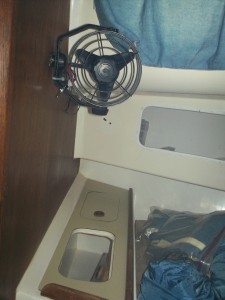
v-berth storage
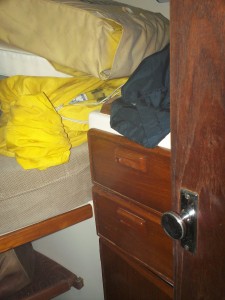
v-berth storage starboard
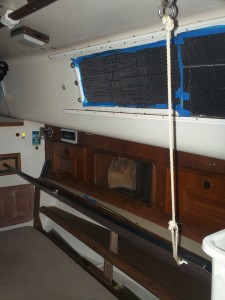
Starboard settee storage
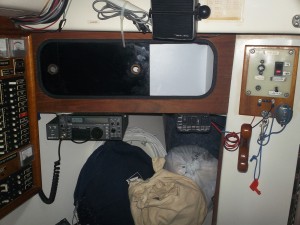
quarter berth starboard aft
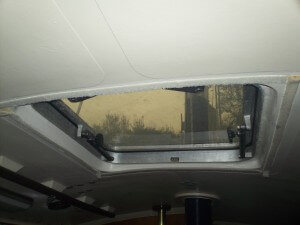
Salon hatch
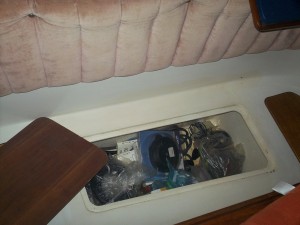
Salon storage port
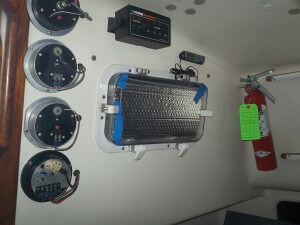
Instruments on galley wall
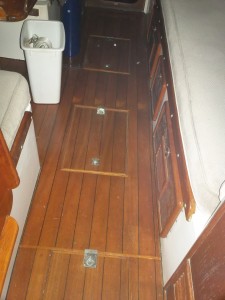
Cabin sole and storage
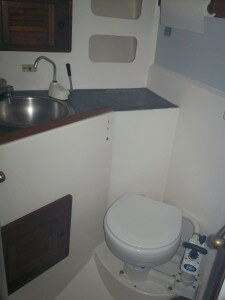
Head (to port)
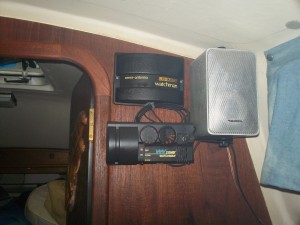
forward bulkhead
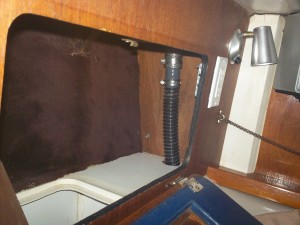
Shag carpet in lockers
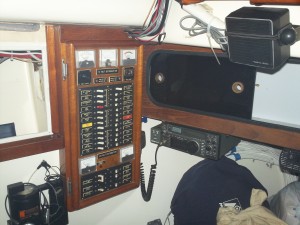
Electric panel at nav station
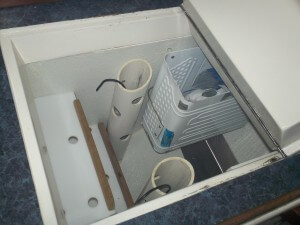
Refrigeration
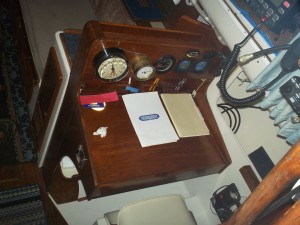
Nav station
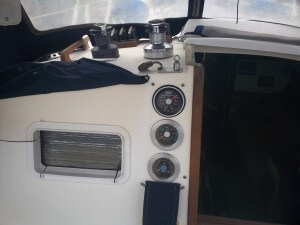
Instruments (cockpit)
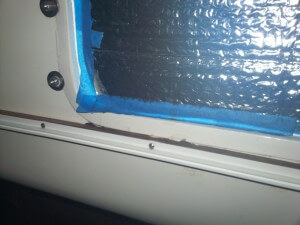
Caper on Yachtworld.com

Cabin (from Yachtworld listing)

Nav station (from Yachtworld listing)

V-berth (from Yachtworld listing)
Please see our post on Cottonwood II for Cabot 36 reviews and additional photos of this design.
15 Responses to Caper – Another Cabot 36
I see you are multi-talented, both as a photographer and as a writer. You would be lauded in my writers’ group with your ability to record and communicate so effectively. Love reading your entries. Good luck finding the ‘perfect’ craft!
Sure am glad we value somewhat different things in boats. We bought Caper today! My right brained fiancée also did not like the cushion colors–we’ll get around to that. But Caper is essentially ready to paint the bottom and launch for a safe and comfortable ride to the Bahamas (or beyond for that matter).How often do you see that in a boat this size in this price range? Did you look at that custom bowsprit? The overkill Lofrans Tigres anchor windlass. The oldy but very-goody (and recently reconditioned) Alpha autopilot? The airex cored hull? Even a high-end windvane and a wind generator. And, finally, the generally meticulous and thorough maintenance the current owner lavishes on her. New sails! We’re sixty something’s, so the slightly clunky look of the behind-the-mast main roller furler is vastly outweighed by its convenience and simplicity.
I sailed around the world in a Whitby 42 and basically had to give her away when I arrived home with 30000 miles worth of problems, no money, and a softer than soft market (2009). I thought I’d never have a boat as good. Turns out, with Caper, I have a similar, but better built and equipped boat, by the same designer, for a quarter of the price I paid for the Whitby in ’97. I actually had tears in my eyes this afternoon when I signed the acceptance and realized my amazing and unforeseen good fortune.
We had seen Caper on Yachtworld and been interested this fall. Soon thereafter we ended up as next boat neighbors at a work yard in Florida (Green Cove Springs) with Joe Hamilton, one of the brokers in the agency handling Caper. He was one of the most knowledgable, generous-with-time, and personable brokers I have ever met and he took an interest in our vague 5 foot fever search without pushing anything. I kept reading about Cabots and liking what I read. Then in the Bahamas, in our current boat, a Bristol 30′, we came into an anchorage and I was struck by the beauty of one of the boats already anchored. Was it maybe a Cabot? We got to know the owners and soon got an invitation to look her over, having expressed our admiration and interest. These folks know a lot about Cabots (they have a cultish following) and actually know, and admire, the owner of Caper. (It’s a pleasantly multilevel name which we will retain. Primary meaning: a native of Cape Breton, where the Cabots were built, sort of like “Newfie”.) They gave us the skinny on the 36: no racer, but comfortable, strong and safe. We went to look at Caper the minute we got to Florida.
Talk about meant to be!
I hope you have similar good fortune in finding a boat you love and are happy on.
Congratulations! I am very happy that you found an awesome boat and that Caper ended up with such good owners. As I hope I made clear in the post, I think you are getting a fabulous boat. I knew she would make someone very happy, but we also knew it was not going to be us! And, you are correct, Joe Hamilton is a extremely generous and knowledgeable broker. You are lucky to have gotten to work with him.
Best of luck with Caper. Hopefully we will see you somewhere down the road.
I have a Cabot 36 in Newfoundland Canada, awesome blue water comfortable boat, have owned numerous boats over forty years but nothing can touch the Cabot for North Atlantic.
Len, sorry your reply slipped by us. We have received many more comments on the Cabot posts than anything else we have put up. They certainly have a following. We routinely talk about making a trip up your way next summer. Do you have any good suggestions for places to stop and things to see?
Sorry to comment on such an old posting, but I wanted to pose a question to you. If you could have had Caper for around $25k, how would it have changed your decision making process while searching for boats?
I ask because my wife and I have just had an offer accepted on Caper, and found your blog post shortly after. I noticed it was in the $45k range at that point, and I’m hoping we were correct in jumping on the boat at a low cost.
First off, congratulations on getting the offer accepted. Buying a boat is exciting, and, at least in our experience, owning one is even better.
We received an email from someone else who was considering Caper a few weeks back, so I will just include some of my response to them:
Margaret’s immediate response to your email was to say that Caper would be a steal for under 25k. I tend to agree with her, but also caution – if you do not have experience with boats already – that there can certainly be a lot of hidden costs in any boat. And I really encourage you to, as I imagine you planned on, going over her carefully yourself and, if you are still interested, with a surveyor.
Caper seemed to be a boat that would be more or less ready to sail away, but there are a few things you will probably want to address before that. There are, as we indicated in our blog post, a lot of older electronics and an aging bimini and dodger. These certainly need to be replaced sooner rather than later (and we never actually tested any of the electronics when we were aboard). Just replacing the bimini and dodger could run you 10k+ (unless you were going to do it yourself…then maybe 3k+, including the Sailrite machine). The engine is 20+ years old, and that would be another thing to look into; diesels can run forever if well maintained, but the cost of replacing one is probably about what you are paying for the boat. I cannot remember the condition of the rigging, so that should be something to check into carefully as well. The sails were in great shape, and unless they have some issues with mold, should be in just as good order.
Since she has been sitting on the hard in Florida for the last four years, I would also want to take a good look at her again to be certain there are not any new problems. At the very least, with all the time it has spent unattended, you should be able to get a good idea as to whether there are any leaks in the cabintop and deck. I would also be sure to get a good survey of the boat, if only so you can have a well-founded punch list to start working your way through as you get the time and funds.
I see that the current listing broker is Dennis Dodge with Advantage Yacht Sales. Joe Hamilton had been with that broker and may very well still be. He was a great guy who seemed very honest. He was not the person we were working with with Caper, but he ended up showing me a Union 36 a few weeks later. You might want to try to get in touch with him. He can give you some real honest info about Caper and, if our experience was any indication, also point out some other real steals that he has come across. The contact I have for him is [email protected] . I also have a cell, which I will send you by private email. They might still be of some use.
Now, to add a couple further comments:
In conversation with the other person interested in Caper, we learned that Caper has most likely not been sitting on the hard for the last several years. He thought that someone else had purchased Caper, used her some, and then decided to move into another boat. You probably know some more details about this. But my point is that some of my information above about Caper sitting for a while may not be accurate. It might also be that the previous owner took care of some of the issues that I highlighted above. So, some of the concerns I noted above might not be so relevant, and there may be some new issues to consider. Regardless, it seems like you have a good deal on a solid boat. I would just encourage you to, as I said above, look her over carefully and get a survey.
Once again, congratulations. You should have a lot of fun and rewarding hard work in front of you. Please let us know how it goes with Caper.
Best, Jeff and Margaret
i am the new owner of a 1977 cabot 36 in nanaimo BC called Relentless. can anyone tell me what the hull and deck construction is?
I need the exact length of the forestay; would you be able to measure yours, if it’s not yet vertical? Wilson
Wicked good boats! You have the same year of manufacture that I do; mine being hull #45. We live right here in Sydney, NS, home town of the Cabot. Though I just bought mine late September 2016, we have since sailed the Atlantic shores as far as Newfoundland and St Pierre & Miquelon, still owned by France. We had decent weather and the boat handled very well. Give me your email and I will send you a short video. Suggested that the Cabot has a bit of weather helm, the previous owner moved the forestay on to an extended bowsprit, adding some 36″ forward. Thinking about moving it back to its original location because even in a small bow we have absolutely no helm at all. Anyways, the hull was made of fiberglass of course which sandwiches a core of Airex, no to be at all confused with balsa. Airex is super strong and DOES NOT absorb water, The decks are cored with marine plywood I believe, but will confirm. I have a fair bit of information re the construction that I’d be happy to copy and send to you. I love my boat and plan to head south to the Bahamas, etc. come fall. Hope this helps, and I’d enjoy chatting.
Wilson Eavis SV Goin’ On
i have acquired a very strange cabot which is suppose to be hull number 41, built in 1977, originally called KARA 1. She is now in Nanaimo BC undergoing a refit. There was some damage to the keel that necessitated a fairly major repair . When the fiberglass was ground away we found that the lead keel was bedded in sand, about 4 inches under it, and all around the sides from what was visible through the hole. There is now a considerable void where the sand was displaced. The fiberglass repair guy wants me to fill it with concrete before he does his repair. The other thing is that there is no airex foam in this Cabot. I have drilled many holes in various places and no foam . I think the entire hull is a solid lay-up. Can anyone shed any light on this mystery.
Have you found anything out yet, Ray? The Cabots certainly have an interesting history. What are your plans for the vessel?
You may find that because of the age of that boat vs the available product you may find that the earlier renditions would have a different product for the inner core. The Cabots were built custom not mass produced. If you wanted one you basically ordered it and production would start other than if there was a slow period for the shop and they decided to build one on spec to stimulate some business.
Hey guys, I am the new owner of a 1977 Cabot 36, hull #33, Blue Magic. Do you have any information on fuel tank size, water tank, holding tank? She’s a beauty and I think we got a good deal on her but some info is missing. Any info you have on the boat would be greatly appreciated. I’ll be glad to share my experiences with the group.
Many thanks in advance, Skipp Maiden [email protected]
Hello Skipp. Congratulations on the recent purchase! We ended up with a Tayana 37, so I have not kept most of our old data on the Cabot. I do remember that we did some deep searching on the internet and found quite a bit of information about the yachts, which seemed to be rather standard across the 50 or so hulls they did. If I remember correctly, there was an owners’ group that was small but had a lot of good resources. You might want to search for that if you have not already. Sorry i could not be of more help.
Leave a Reply Cancel reply
Your email address will not be published. Required fields are marked *
Follow us on YouTube
- Search for:
Recent Posts
- Bear in Florida – Fall 2019 Update
- Podcast Interview
- Guides to St. John and the Virgin Islands
- Cruising Guides for the Caribbean (Now that we have been there)
- Charts for the Caribbean (Now that we have been there)
Recent Comments
- John Harvan on Podcast Interview
- Jeffrey on A Boatyard Cat, Port Townsend Fittings, and a Much Anticipated Launch
- Oliver Jones on A Boatyard Cat, Port Townsend Fittings, and a Much Anticipated Launch
- Jeffrey on Our Thoughts after Looking at the Southern Cross 31
- Chris on Our Thoughts after Looking at the Southern Cross 31
- November 2019
- August 2019
- February 2019
- January 2019
- December 2018
- November 2018
- October 2018
- August 2018
- February 2018
- December 2017
- November 2017
- October 2017
- September 2017
- August 2017
- February 2017
- January 2017
- November 2016
- October 2016
- August 2016
- January 2016
- December 2015
- November 2015
- October 2015
- September 2015
- August 2015
- February 2015
- January 2015
- December 2014
- November 2014
- October 2014
- September 2014
- August 2014
- February 2014
- January 2014
- December 2013
- October 2013
- September 2013
- August 2013
- February 2013
The Cabot 36 is a 35.58ft cutter designed by Ted Brewer/Robert Walstrom and built in fiberglass by Yachtsmiths International Inc. since 1974.
49 units have been built..
The Cabot 36 is a heavy sailboat which is slightly under powered. It is reasonably stable / stiff and has an excellent righting capability if capsized. It is best suited as a bluewater cruising boat.
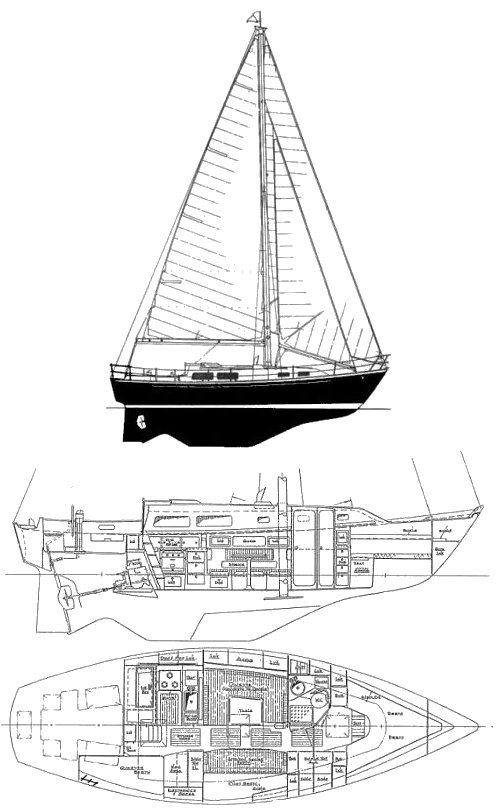
Cabot 36 for sale elsewhere on the web:

Main features
Login or register to personnalize this screen.
You will be able to pin external links of your choice.

See how Sailboatlab works in video

We help you build your own hydraulic steering system - Lecomble & Schmitt
Accommodations
Builder data, modal title.
The content of your modal.
Personalize your sailboat data sheet

Fin with rudder on skeg
Specifications CABOT 36
1974 - 35.58 ft / 10.84 m - Cabotcraft Industries (CAN) - Ted Brewer/Robert Walstrom

CABOT 36 Sailboat Data
Hull Type: Fin with rudder on skeg Rigging Type: Cutter LOA: 35.58 ft / 10.84 m LWL: 29.67 ft / 9.04 m S.A. (reported): 632.00 ft² / 58.71 m² Beam: 11.67 ft / 3.56 m Displacement: 17,800.00 lb / 8,074 kg Ballast: 5,500.00 lb / 2,495 kg Max Draft: 4.75 ft / 1.45 m Construction: FG Ballast Type: Lead First Built: 1974 # Built: 49 Builder: Cabotcraft Industries (CAN) Designer: Ted Brewer/Robert Walstrom
Information from sailboatdata.com .
Hull Speed: 7.30 kn

Great choice! Your favorites are temporarily saved for this session. Sign in to save them permanently, access them on any device, and receive relevant alerts.
- Sailboat Guide
1977 Cabot 36
- Description
Seller's Description
This classic Ted Brewer bluewater boat is well equipped and ready for offshore cruising anywhere in the world. This solid vessel has been regularly maintained, with many recent upgrades. The interior is spacious with standing head room throughout (6’2), and boasts many large windows to let in plenty of natural light, both rare features in a boat of this vintage. The cockpit offers plenty of seating for evening sundowners, while at sea it provides protection during spirited sails. With a hull speed of 6 knots, she is both fast and stout, fun to sail yet safe. Canadian-built, the cutter-rigged Cabot 36 is consistently on lists of the best blue-water boats. She was made for the North Atlantic, but is perfectly at home in its current Caribbean location of sunny St. Martin in the French West Indies.
She has a large private double V-berth cabin with plenty of cupboards for storage, enclosed side shelves and a hanging locker. Separate entrance to the head, which is also accessible from the main salon. The head is equipped with a manual Jabsco toilet with Y valve, sink, shower, and hot and cold pressure water.
The main salon has a U-shaped dinette to port with a large teak table that drops to form a comfortable double berth. The six-foot settee to starboard serves as an ideal single pilot berth for overnight passages.
At the bottom of the companionway there is U-shaped galley to port with a sink with hot and cold pressure water, and sea water and freshwater foot pumps. This boat holds more fuel and water than most midsize cruisers (455 liters/120 gal). The galley also has a Force 10 three-burner stove with oven, and an Isotherm fridge with ice-making capabilities and secondary cool box.
Great access to the newly reconditioned (2024) Yanmar 4JH2E engine. Ultra-suede cushions in good condition. All windows and port lights have been recently replaced. All cabin lights LED.
April 2022 survey available upon request.
With only 49 of these boats ever produced, this highly coveted unicorn of a cruiser could be yours. Come live the Caribbean dream.
Equipment: Keel: Full keel Dimensions LOA: 36 ft Beam: 11.8 ft LWL: 29.8 ft Maximum Draft: 4.9 ft Headroom: 6 ft. Displacement: 18,000 lb Ballast: 5,500 lb
Engines Total Power: 50 hp Engine Brand: Yanmar 4JH2E Engine/Fuel Type: Diesel Engine Hours: 2,800 Propeller: Kiwi prop Cruising Speed: 6 kt
Tanks Fuel Tanks: 2 Fuel Tank Capacity: 302 L (80 gal) Water Tanks: 2 Water Tank Capacity: 455 L (120 gal) Waste Tank: 100 L (26 gal)
Accommodations Number of twin berths: 2 Number of double berths: 2 Number of cabins: 1 Number of heads: 1
Sails Main sail 2007 140% Furling Genoa with blue UV cover on ProFurl furler, good condition Hank-on staysail, good condition Spinnaker
Navigation B&G 3G radar, depth sounder and electronics (2018) Standard Horizon VHF radio and AIS (2022) Simrad wheel pilot Aries windvane
Canvas Dodger, bimini with connecting panel and optional full enclosure 2010 Main sail stack pack with lazy jacks 2015
Ground tackle New Rocna 20 installed in 2019 on Lofrans X2 1000 watt windlass with 185 ft of 10 mm x 30 chain (2017) Secondary anchors: o Danforth o Fortress (stern anchor)
Deck hardware 12 mm Lexan hatches (2017) Winches: 2 on deck, 2 self-tailing Harken 48s in cockpit, 3 on mast. SS cowlings Main saloon windows replaced with 3/8 Lexan in 2021 New Beckson port lights in 2022 New soft sand non-skid on top deck 2023 Safety bars installed at mast in 2023
Dinghy Aruba 9.8 ft 2017 Nissan 9.8 hp outboard, 2019
Electrical Balmar 100amp alternator All new batteries in 2022 o 2 Victron liquid carbon house batteries o 12V starter 440 watts of solar 2020 Blue Sky controller
Rigging Bowspirit extended 20” All standing and running rigging has been replaced in the last 6 years.
Hull Hull sanded back to gel coat, re-primed and two coats of hard PPG antifouling applied in 2022 Rudder re-cored in 2018
Cockpit Upper lifelines replaced in 2022 Solid stainless steel handrails in cockpit Garhauer crane Weber rail-mounted barbecue
Plumbing 6 gallon hot water tank New sanitation hose in 2018 Brand new 100L waste tank in 2023 Jabsco toilet with manual pump Overboard macerator pump Shower pump
Galley Isotherm 41 installed below counter with additional 20 L cool box Force 10 three-burner stove and oven (propane) Stainless steel sink with salt water and fresh water foot pumps and freshwater pressure tap with hot and cold water
Interior Floors newly varnished in 2022 All lights LED Dickinson diesel heater
-Automatic and manual bilge pumps. -Variety of spare parts. -Well-equipped toolbox. -Fire extinguisher. -2X Propane tanks in cockpit lockers plus spare tank for barbecue. -Variety of dock lines. -Five fenders. -Two extendable aluminum boat hooks. -U-shaped life ring. -Air horn and flares. -Swim ladder for use on port side. -Kerosene cabin light. -20L fuel cans for water, diesel and gas. -Extra life preservers. -Anchor light. -Compass/pedestal steering station/teak table cover. -Snorkeling gear. -Merritt sewing machine. -Honda 2000W gas generator (2017).
Rig and Sails
Auxilary power, accomodations, calculations.
The theoretical maximum speed that a displacement hull can move efficiently through the water is determined by it's waterline length and displacement. It may be unable to reach this speed if the boat is underpowered or heavily loaded, though it may exceed this speed given enough power. Read more.
Classic hull speed formula:
Hull Speed = 1.34 x √LWL
Max Speed/Length ratio = 8.26 ÷ Displacement/Length ratio .311 Hull Speed = Max Speed/Length ratio x √LWL
Sail Area / Displacement Ratio
A measure of the power of the sails relative to the weight of the boat. The higher the number, the higher the performance, but the harder the boat will be to handle. This ratio is a "non-dimensional" value that facilitates comparisons between boats of different types and sizes. Read more.
SA/D = SA ÷ (D ÷ 64) 2/3
- SA : Sail area in square feet, derived by adding the mainsail area to 100% of the foretriangle area (the lateral area above the deck between the mast and the forestay).
- D : Displacement in pounds.
Ballast / Displacement Ratio
A measure of the stability of a boat's hull that suggests how well a monohull will stand up to its sails. The ballast displacement ratio indicates how much of the weight of a boat is placed for maximum stability against capsizing and is an indicator of stiffness and resistance to capsize.
Ballast / Displacement * 100
Displacement / Length Ratio
A measure of the weight of the boat relative to it's length at the waterline. The higher a boat’s D/L ratio, the more easily it will carry a load and the more comfortable its motion will be. The lower a boat's ratio is, the less power it takes to drive the boat to its nominal hull speed or beyond. Read more.
D/L = (D ÷ 2240) ÷ (0.01 x LWL)³
- D: Displacement of the boat in pounds.
- LWL: Waterline length in feet
Comfort Ratio
This ratio assess how quickly and abruptly a boat’s hull reacts to waves in a significant seaway, these being the elements of a boat’s motion most likely to cause seasickness. Read more.
Comfort ratio = D ÷ (.65 x (.7 LWL + .3 LOA) x Beam 1.33 )
- D: Displacement of the boat in pounds
- LOA: Length overall in feet
- Beam: Width of boat at the widest point in feet
Capsize Screening Formula
This formula attempts to indicate whether a given boat might be too wide and light to readily right itself after being overturned in extreme conditions. Read more.
CSV = Beam ÷ ³√(D / 64)
Some were sold as bare hulls and finished by others. An updated version was available beginning in 2008 from:
YachtSmiths International of Canada 2 Maitland St. Dartmouth, Nova Scotia, Canada B2Y 3L7 Phone: (902) 463-0741 Toll Free: 1 866 856-7848 Fax: (902) 463-3664 Email: [email protected] www.yachtsmiths.com
This listing is presented by SailboatListings.com . Visit their website for more information or to contact the seller.
View on SailboatListings.com
Embed this page on your own website by copying and pasting this code.
- About Sailboat Guide
©2024 Sea Time Tech, LLC
This site is protected by reCAPTCHA and the Google Privacy Policy and Terms of Service apply.

- Forum Listing
- Marketplace
- Advanced Search
- About The Boat
- Boat Builders Row
- SailNet is a forum community dedicated to Sailing enthusiasts. Come join the discussion about sailing, modifications, classifieds, troubleshooting, repairs, reviews, maintenance, and more!
Should I even consider a c-36 MK1?
- Add to quote
I've been around a lot of Catalina 30s and I'm very familiar with the "smile" and all the efforts my friends used to make to reduce the smile. the plywood in the keel stubs troubles me, and because I know about woodworking it troubles me even more! If anyone can +- thoughts on this, please sound off!
Wow! Haven't seen you post here in years! The Cat 36 (and the very similar 34) were made for a lot of years. Also lots of variations - keels, regular and tall rig, Mk 1, 1.5, 2, etc. The Cat 36 Mk 1 was built into the 90s so I am sure lots of changes over it's long run. Owners association is probably the best source for specific info.
Wood was only used in the keel stub prior to 1988.
The Catalina 36 had an uncored, solid fiberglass hull. I'd recommend the version with frameless portlights. I think those also had decks cored with end grain balsa rather than plywood. The "Catalina smile" was usually caused by a hard grounding, not by faulty design or construction. Examine it carefully, as you would any boat, and have it surveyed. If the decks are solid, there are no leaks, and the engine and drive train are good, then why not consider it?
Well, yes the MK1 would be in that vintage with the plywood in the stub Basically there is plywood in the keel stub as mentioned earlier up until about 1988 and they use plywood it's just a matter of when it will get soggy not if and I pretty much decided I'm not going to go with any of the Catalina models that have plywood in the stub, which actually is more of the cause of the smile than a grounding
The Mark I was built through 1993. capttb says "wood was only used in the keel stub prior to 1988." I have heard the same elsewhere, but would suggest you confirm that with a phone call to Catalina. If so, a wooden keel stub would not be a concern for about 5 production years of the C36 Mark I.
Welcome back, Denise. I'd love to see you out end up with another boat. I'm sure you'll choose wisely.
This pdf from Catalina regarding repair notes the pre 1988 construction, and I've seen another I can't find right now that is a detail build plan for later models also notes 1989 as cut-off for use of wood. https://www.catalinadirect.com/imag...c0fae36d5-F4CB6567-A7E6-6802-4ACC0354C525F998
capttb said: This pdf from Catalina regarding repair notes the pre 1988 construction, and I've seen another I can't find right now that is a detail build plan for later models also notes 1989 as cut-off for use of wood. https://www.catalinadirect.com/images/features/Keel Stub Wood Removal.pdf?CFID=11324753&CFTOKEN=89acc1ac0fae36d5-F4CB6567-A7E6-6802-4ACC0354C525F998 Click to expand...
We got a bigger slip with the intention of getting a C36 when we were surprised to learn my wife couldn't handle the companionway steps. She nearly lost a leg due to traumatic injury and it doesn't function very well. She doesn't have a problem with our boat. I'd look for an alternative but the market here is nuts, I've been offered $10,000 more than I paid for my boat 12 years ago. Maybe when the dust settles on this pandemic I can find a nice 355 or 375. I've had 3 boats built since the 90's, a '94 Capri 26, '94 Cat270, and now an '02 320 no major structural problems on any and I sold them for about the same as I paid for them. After new sails, upholstery, canvas, varnish, detailing etc.
There are quite a few older C-36 out there. Looking suggested methods from Catalina to fix the plywood compression, what comes to mind and mind is a a few dozen small holes (1/4"?) A small flood of acetone to drive out the moisture, then small flood of very thin stabilizing penetrating epoxy like Smith's or git rot. I'm not opposed to hard work but I'd rather not have to go through all that which is one of the reasons I look at small trawlers but they have their own set of problems (engine repairs and costs)
I got a call back about a c-36 MK1 1993 I believe it's the last year before the MK-II. Cast iron keel I think it would have.
Nope, lead, Catalina uses lead keels. Brochure for '92 http://www.catalinayachts.com/wp-content/uploads/2016/12/Cat-36-Brochure-1992-PDF.pdf
Catalina Yachts for sale | YachtWorld
Log into Facebook

just be sure that Albin 28 does not have the Peninsular diesel. If it does RUN!
Welcome back Denise! Did you know that O'day makes a nice boat too? I understand that you are looking at boats from 34 to 36 feet. You can find O'day 35s on Yachtworld with asking prices from $19.5K to $41K. You can find O'day 34s from $19.5K to $31K. Selling prices, as you know, will be less than asking.
Thank you for the warm fuzzies! yes I had a Oday so I do know that!
It seems the most viable of the candidates to date, remembering the prime objective of sailing more and working less. Hope your inspection goes well.
Yes but at 28 years, it is still an old boat!
Denise, I just noticed your post regarding the Albin 28 express. I've been looking an albin myself. There was a 32 parked next to me last winter. I've been cautioned by my mechanic that the engine access is less than optimal. I have yet to get a close up look at what he's talking about. But every Albin owner t've talked to loves their boat. I intend to investigate further. Good luck with whatever you decide. BTW my slip neighbors own a 35 o'day, and as you know it's a great boat. Sails very nicely!
The one in the picture I did not follow up on because it has a GM 6.5 diesel which are known for cracked heads and bunch of other problems. I don't know guessing the mechanic is just throwing judgments out without really looking because I did read up on the owners forum and they love them. And the so-called v drive is actually the transmission not the nightmare that most people think about V drives in the past. if it had the 300 horsepower yanmar I may have made jump! you don't have to be a financial wizard to know a 300 HP repower it's beyond most people's means! I'm still waiting to hear back on Albin 27 but the guy didn't seem to care or even to be interested.
deniseO30 said: I went, I saw, did not expect much, and got even less! Think about this way; you walked out of the house left everything for some reason or another and then come 2 years later decide to sell, Electric heaters were still on from the winter although there were on standby they were definitely energized, no line on the furler, no water in the oil, about the only thing I could check, the sole boards were screwed down couldn't check any of the bilges. Engine wouldn't even crank, lots of towing invoices lots of bills for new batteries over the years so something's wrong electrically is my guess, I threw him a number and walked. Was and could be a beautiful boat (definitely a big boat!) But the thing hasn't been commissioned in years. He asked me if they got it commissioned would I look at it again, I said maybe, but personally I feel not likely. View attachment 139762 , Click to expand...
I could not find one crack in the gel coat anywhere which really impressed me I forgot my phenolic hammer or screwdriver to tap on it but I did some banging on it with some other stuff and my hands and feet was very solid no evidence of water getting down from the top or on the window frames I believe it was a mark 1.5 but I'm beyond caring they just let too much go and with their friend thinking he could sell it as is,
ARRG! Pretty much decided to buy the little Albin 27 and I get a text from the broker about the Catalina 36 they had it commissiond it starts and runs they are having the bottom cleaned by a diver so my big questions now would only be on the keel bolts, Catalina smile, water intrusion of the rudder I don't know if I really want to revisit though it has the potential to be a beautiful boat and lots of living space ARRG ARRG ARRG! 😱
The answer comes down to you. The two driving questions are: 1) Realistically how often do you think that you will actually sail the boat? 2) Given your travel plans, is the nuisance of deeper draft and air draft, worth the tradeoff in fuel savings and the joys of sailing. Jeft
Good points Jeff! it's already set up for single-handing. she is a big boat like a tiny house even (without wheels) which is what I really want Pretty sure she needs a new sails, even used, that's not cheap for a boat that size. so I'm going to think on it before I return the guy's call I'm already set to go see the little albin on Tuesday. And it's at less than half the cost of the Catalina. Thank you!
Jeff, anyone, do you have any information on the wing keel it's a shoal draft model. I can't find a picture and measurements of the wing keel and I'm usually good at finding stuff online!
Sail data says 4.43'
Yes thank you and that's about the kind of pictures I could only find. But no close up with actual dimensions and attachment points.
Denise, I think by 1993 Catalina had eliminated the root cause of the smile (wood in keel sump). You definitely want to haul out and check it, but if keel nuts have been kept properly tightened, there should be no smile.
TakeFive said: Rick, I think by 1993 Catalina had eliminated the root cause of the smile (wood in keel sump). You want to haul out and check it, but if keel nuts have been kept properly tightened, there should be no smile. Click to expand...
- ?
- 174.4K members
Top Contributors this Month
- New Sailboats
- Sailboats 21-30ft
- Sailboats 31-35ft
- Sailboats 36-40ft
- Sailboats Over 40ft
- Sailboats Under 21feet
- used_sailboats
- Apps and Computer Programs
- Communications
- Fishfinders
- Handheld Electronics
- Plotters MFDS Rradar
- Wind, Speed & Depth Instruments
- Anchoring Mooring
- Running Rigging
- Sails Canvas
- Standing Rigging
- Diesel Engines
- Off Grid Energy
- Cleaning Waxing
- DIY Projects
- Repair, Tools & Materials
- Spare Parts
- Tools & Gadgets
- Cabin Comfort
- Ventilation
- Footwear Apparel
- Foul Weather Gear
- Mailport & PS Advisor
- Inside Practical Sailor Blog
- Activate My Web Access
- Reset Password
- Customer Service
Practical Sailor
- Free Newsletter

Beneteau 323 Used Boat Review

How to Perform Your Own Pre-Buy Inspection
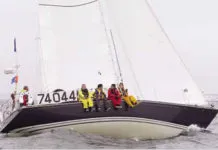
C&C 40 Used Boat Review
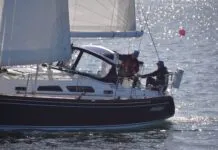
Sabre 386 Used Boat Review

How Does the Gulf Stream Influence our Weather?

Can You Run a Marine Air-Conditioner on Battery Power?

Preparing Yourself for Solo Sailing

Your New Feature-Packed VHF Radio

Ground Tackle Inspection Tips

Shoe Goo II Excels for Quick Sail Repairs

When Should We Retire Dyneema Stays and Running Rigging?

Rethinking MOB Prevention

An Unusual Sailboat Shines a Light On A Sustainable Future

Is It Time to Get an Electric Dinghy Motor?
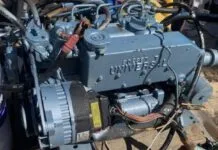
Worship Your Universal M-Series Diesel With the Marinized Kubota Block

Bottom Paint 30-Month Update

Battle of the Teak Cleaners — Snappy Teak-Nu vs. Star Brite

New Seacocks for the Offshore Sailor

Bottom Paint Care

Are E-bikes Worth the Extra Weight and Cost?

How to Handle the Head

How to Select Crew for a Passage or Delivery

Preparing A Boat to Sail Solo

Re-sealing the Seams on Waterproof Fabrics

Waxing and Polishing Your Boat

Reducing Engine Room Noise

Tricks and Tips to Forming Do-it-yourself Rigging Terminals

Marine Toilet Maintenance Tips

Learning to Live with Plastic Boat Bits
Sign up for Practical Sailor's FREE e-letter!
We spend our time and money so that you can save yours!
And that's important when you are buying a boat.
Practical Sailor is different. Its candor is as sharp as a marlinspike and its honesty as welcome as a steadfast quartering breeze. And that goes for its acclaimed boat reviews.
We take a revealing look at each boat's specifications and construction. Our experts sail the boat offshore and check its performance and livability. They note how it handles under sail and power. And then we report everything we discovered back to you.
See what PRACTICAL SAILOR has to say for FREE by signing up for the email newsletter "Waypoints".
Sailboat reviews and specifications and more!
- Privacy Policy
- Do Not Sell My Personal Information
- Online Account Activation
- Privacy Manager

COMMENTS
More than 40 years after the first Cabot 36 cutter was built in Canada, the boats remain cherished by their owners and the stuff of dreams for sailors looking to purchase one. ... In a review about keel design, Brewer wrote that the "bite" is a way to modify a full keel. ... The Cabot 36 is a traditional fiberglass boat built from a mold ...
Cabot 36 vs Morgan 38. Being definite fans of Ted Brewer boats we have been wondering structurally etc which design would be the best long term live aboard/blue water cruiser for the South Pacific. Or is the Morgan just a larger version of the Cabot. The Cabot is a 1978 and the Morgan 383 a 1983. Also would be interested in hearing from any ...
Cabot 36. Goin' On is a 36 foot Cabot. She was built in Sydney, Nova Scotia and has had three owners since her initial splash in 1977. The Cabotcraft Industries company was a Federal Government sponsored project that eventually went out of business in 1979 to end this great production era. Goin' On is hull number 45 out of some disputed 60 ...
Some were sold as bare hulls and finished by others. An updated version was available beginning in 2008 from: YachtSmiths International of Canada. 2 Maitland St. Dartmouth, Nova Scotia, Canada. B2Y 3L7. Phone: (902) 463-0741. Toll Free: 1 866 856-7848. Fax: (902) 463-3664.
The Cabot 36 is equipped with a long keel. A long keel provide a better directional stability than a similar boat with a fin keel; on the other hand, better directional stability means also that the boat is more difficult to handle in a harbour with less space. The keel is made of lead. Compared with iron, lead has the advantage of being 44% ...
The Cabot 36 sailboat is a Canadian classic sailing yacht that was built in the 1970s in Sydney, Nova Scotia from plans and drawings by the famous design team of Ted Brewer and Bob Walstrom. Only 49 Cabots were produced by Cabotcraft Industries, which folded in the late '70s when orders and government funding diminished and the market for sailing vessels hit a slump in both Canada and the U.S.
Brewer drew a conservative, but very capable, ocean cruiser. The Cabot 36 was always meant as an offshore cruiser not a cruiser/racer. At that time the Westsail 32 was selling like hotcakes and popularizing the idea of long-distance cruising. While the Westsail was a capable boat, it was based on a William Atkins design from the 1920s.
CABOT 36 - Cruiser - "SHoGUN". · Excellent condition, 2nd owner - had for 30 years. · Cutter rigged, designed by Brewer and Wallstrom - 1978. · 6 berth, with oven, stove, fridge, freezer and shower. · 50 hp Perkins engine with 70 gallons of diesel. · 140 gallons of water. · Dinghy and 1.2 hp engine.
Cabot 36 is a 35′ 6″ / 10.8 m monohull sailboat designed by Edward S. Brewer and built by Yachtsmiths International Inc. starting in 1974. ... The lower a boat's ratio is, the less power it takes to drive the boat to its nominal hull speed or beyond. Read more. Formula. D/L = (D ÷ 2240) ÷ (0.01 x LWL)³ D: Displacement of the boat in ...
Cabot 36. LOA (Length Overall): 35.5′ Displacement: 17800lbs (about 8 tons) Draft: 4′ 9″ Designer: Ted Brewer / Robert Walstrom Built By: Cabotcraft Industries. cabot drawings sailboat. Sailing Vessel Palani is hull number 18 in the Cabot 36 series. She was manufactured in Canada in 1978. She is rigged as a cutter; this means she has ...
Caper - Another Cabot 36. Posted on January 26, 2014 by Margaret. While we climbed down the ladder from Cottonwood II - and presumably the whole time we had been on the boat - Joe and Wally were engaged in conversation about boats. I can only imagine the stories they were swapping about yachts they have owned, ones that they lusted after ...
The Cabot 36 is a 35.58ft cutter designed by Ted Brewer/Robert Walstrom and built in fiberglass by Yachtsmiths International Inc. since 1974. 49 units have been built. The Cabot 36 is a heavy sailboat which is slightly under powered. It is reasonably stable / stiff and has an excellent righting capability if capsized.
Cabot 36 * CAN Ted Brewer design. Very limited production. Caliber 28, 33, 35, 38, 40. * USA Fairly well-built. Michael McCreary designs. LRC models have substantial tankage. The 47 is not an attractive boat. Cambria 40, 44, 46 * USA Fast, well-built, gorgeous and have held their value well. Camper Nicholson 31, 32, 35,
CABOT 36 Sailboat Data. Hull Type: Fin with rudder on skeg Rigging Type: Cutter LOA: 35.58 ft / 10.84 m LWL: 29.67 ft / 9.04 m S.A. (reported): 632.00 ft² / 58.71 m² Beam: 11.67 ft / 3.56 m Displacement: 17,800.00 lb / 8,074 kg Ballast: 5,500.00 lb / 2,495 kg Max Draft: 4.75 ft / 1.45 m Construction: FG Ballast Type: Lead First Built: 1974 # Built: 49 Builder: Cabotcraft Industries (CAN ...
Hopefully this will be a good forum to connect Cabot 36 owners with each other, record hull numbers and boat locations, share information, and discuss any Cabot issues. Please feel free to share this...
With a hull speed of 6 knots, she is both fast and stout, fun to sail yet safe. Canadian-built, the cutter-rigged Cabot 36 is consistently on lists of the best blue-water boats. She was made for the North Atlantic, but is perfectly at home in its current Caribbean location of sunny St. Martin in the French West Indies.
The Cat 36 (and the very similar 34) were made for a lot of years. Also lots of variations - keels, regular and tall rig, Mk 1, 1.5, 2, etc. The Cat 36 Mk 1 was built into the 90s so I am sure lots of changes over it's long run. Owners association is probably the best source for specific info. S/V First Tracks.
36'. 11.8'. 5'. Outside United States. $38,000. Description: This classic Ted Brewer bluewater boat is well equipped and ready for offshore cruising anywhere in the world. This solid vessel has been regularly maintained, with many recent upgrades. The interior is spacious with standing head room throughout (6'2), and boasts many large windows ...
1975 Cabot 36 A Canadian classic, the Ted Brewer-designel Cabot 36 is a classic cruising vessel built for bluewater sailing. They don't make them like this anymore - strong build, superior handling, ocean going capable are only some of the Cabot 36's legend.
Used Cabot 36 1 listing. Find Cabot 36 boats for sale in your area & across the world on YachtWorld. Offering the best selection of Cabot boats to choose from.
Review of Cabot 36. Basic specs. The Cabot 36 is a sailboat designed by the Canadian maritime architect Edward S. Brewer together with Robert Walstrom from in the mid seventies. Less than 100 boats have been produced. The Cabot 36 is built by the Canadian yard Cabotcraft Industries.
In fact, the Cabo 36 Express weighs as much or more than most other boats in this class, tipping the scales at 25,750 pounds. Most expresses in this size range will weigh in between 1,500 and 5,000 pounds less. Combine that hefty displacement with the 17.5-degree running bottom, add in the stout construction, and you'll have no problem ...
All Multihulls New Sailboats Sailboats 21-30ft Sailboats 31-35ft Sailboats 36-40ft Sailboats Over 40ft Sailboats Under 21feet used_sailboats. How to Perform Your Own Pre-Buy Inspection. C&C 40 Used Boat Review. ... And that goes for its acclaimed boat reviews. We take a revealing look at each boat's specifications and construction. Our experts ...